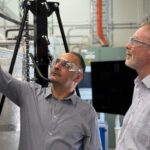Timely development of physical infrastructure and effective economic diversification can secure the long-term future of the Pilbara.
This is amongst the conclusions drawn in a new Curtin University Sustainability Policy (CUSP) report Pilbara 2050: Ensuring the long-term viability of the Pilbara.
The report investigates what type of future could be created for the Pilbara beyond the current iron ore and natural gas boom.
CUSP Senior Researcher, Jemma Green said the Pilbara could be seen as the region that has won the lottery twice, first through the discovery of iron ore in the 1950s and later when natural gas was discovered in 1971.
“It is a classic example of prosperous growth in a natural resources region, with the boom outstripping the ability to develop infrastructure to service it properly.
“History shows that this classic mine-and-boom phase is either followed by an evolution into multiple but related industries, or a decline into ghost town and tumble weed,” Ms Green said.
“The difference between evolution and decline for the Pilbara can be determined by forward thinking and sound planning. This can unlock the region’s undeveloped potential for economic diversification and ensure its long-term economic viability.
“When a boom dries up what is often left is secondary and tertiary infrastructure. This can be enough to sustain a region, but only if such infrastructure has already been created.
“The obvious solution for the Pilbara is to facilitate the growth of a mining / natural gas ecosystem in order to avoid the ghost town scenario,” Ms Green said.
Pilbara 2050 argues that the Pilbara region has yet to determine a comprehensive economic vision which quantifies the economic size of opportunities and targets, along with pathways to get there.
It stipulates the Pilbara needs to invent a future –diversified from gas and iron ore – and find new means to cut costs and maintain profit margin.
The paper includes an audit of Pilbara infrastructure, policies, programs and initiatives, a gap analysis of need, and a comparison against other places in Australia and around the world.
Researchers have developed a wish-list of what needs to materialise to ensure the Pilbara’s long-term economic viability, supported by an investigation about how these could work.
Ms Green said major diversification opportunities exist around tourism, industrials, technology and agriculture.
“There are also opportunities to rationalise major infrastructure such as power generation and transmission, develop renewable energy generation, and consolidate and electrify rail transportation”.
The long-term economic viability framework outlined in Pilbara 2050 would provide an initial pathway to creating an economically and socially resilient Pilbara for the future.
The report also emphasised it will be imperative for the government to play a direct and ongoing role if the long-term vision for the Pilbara is to be achieved.
“The government should steer infrastructure development in the region and ensure that private sector-led developments favour infrastructure, representing the best interests of the region, rather than those that have the most political appeal,” Ms Green said.
“The Pilbara has the potential to become a resilient economy and community. However, this will greatly depend on whether the political will exists to do so.”
The complete Pilbara 2050 report can be downloaded at www.pilbara2050.net



